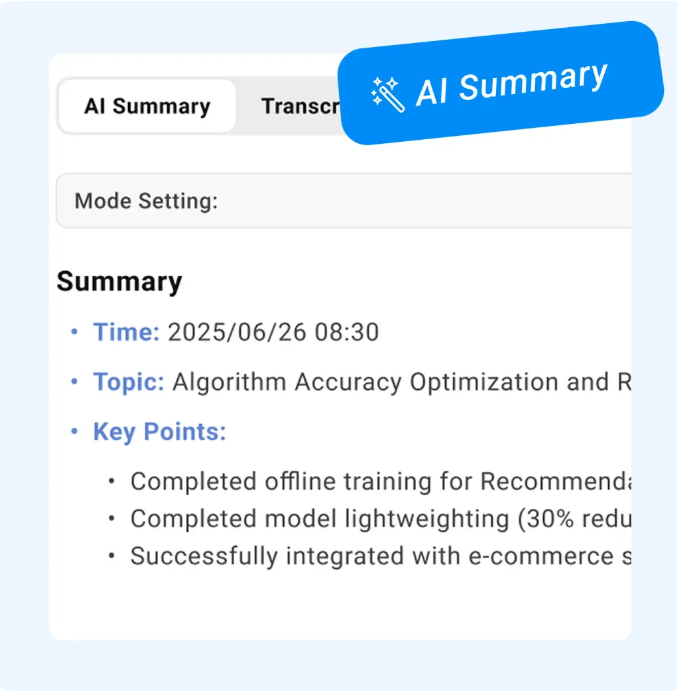Professionals spend an average of 18 hours per week in meetings, yet studies show that nearly 70% of participants struggle to recall key decisions just days later. The culprit? Manual note-taking that divides attention, creates incomplete records, and leaves action items buried in scattered documents. While you’re frantically scribbling notes, you’re missing crucial context and nuanced discussions that drive business forward.
Transcription tools are emerging as the antidote to meeting fatigue, transforming how teams capture, process, and act on conversations. These AI-powered solutions automatically document every word spoken, generate searchable transcripts, and extract actionable insights without human intervention. The benefits extend far beyond simple recording: instant meeting summaries, automated action item tracking, and permanent searchable archives that turn ephemeral discussions into institutional knowledge. This technology isn’t just changing how we document meetings—it’s revolutionizing how efficiently we can turn conversation into execution.
Table of Contents
The Meeting Efficiency Crisis: Why Professionals Need Solutions
The numbers paint a sobering picture: knowledge workers spend between 15-18 hours weekly in meetings, consuming nearly half their work time. Yet this massive time investment yields surprisingly poor returns. Manual note-taking fragments attention, forcing participants to choose between active listening and documentation. Research shows that handwritten notes capture only 30-40% of meeting content, with critical details vanishing the moment pens lift from paper. The result? Inconsistent records where three attendees leave with three different versions of what was decided.
This documentation gap creates cascading accountability problems. Action items get lost in translation, deadlines slip through cracks, and teams waste hours reconstructing decisions from fragmented memories. Follow-up meetings become necessary just to clarify what happened in previous ones. The financial impact is staggering—organizations lose an estimated $37 billion annually to unproductive meetings. When employees can’t recall who committed to what, projects stall and momentum evaporates. The traditional meeting model isn’t just inefficient; it actively undermines the collaboration it’s meant to facilitate. Digital transcription solutions address this crisis at its source, transforming meetings from memory tests into documented, actionable workflows that preserve every decision and commitment with perfect fidelity.
Beyond Recording: How Modern Transcription Tools Work
From Audio to Actionable Text: Core Technology Explained
Modern transcription tools leverage artificial intelligence and natural language processing to transcribe audio to text with remarkable precision. Unlike basic voice recorders with transcription that simply capture audio and apply rudimentary speech-to-text conversion, AI-enhanced platforms analyze speech patterns, context, and linguistic structures to deliver nuanced, accurate transcripts. These systems employ neural networks trained on millions of hours of conversation, enabling them to understand accents, industry jargon, and conversational flow that would confound simpler technologies.
The processing approach varies significantly between solutions. Real-time transcription generates text as people speak, allowing participants to see live captions during meetings—invaluable for accessibility and immediate reference. Post-meeting processing typically delivers higher accuracy by analyzing complete audio files with full contextual understanding, producing polished transcripts within minutes of meeting conclusion. Machine learning continuously improves accuracy as these systems encounter new vocabulary and speech patterns, with leading platforms now achieving 90-95% accuracy even in challenging audio conditions. This learning capability means your transcription tool becomes more effective over time, adapting to your team’s specific terminology and communication style.
Meeting-Specific Features That Change the Game
Speaker identification technology distinguishes individual voices in multi-person conversations, automatically labeling who said what throughout the transcript. This feature transforms chaotic group discussions into organized, attributable records where accountability is crystal clear. Advanced noise cancellation filters out keyboard clicks, air conditioning hum, and background chatter in busy office environments, ensuring clean audio input that translates to cleaner transcripts. These tools integrate seamlessly with video conferencing platforms like Zoom and Microsoft Teams, joining meetings as virtual participants that record and transcribe without requiring separate setup. Calendar integration enables automatic meeting detection and transcription initiation, eliminating the risk of forgetting to hit record. Cloud storage ensures transcripts are instantly accessible across devices and shareable with stakeholders who couldn’t attend, creating a centralized knowledge repository that survives employee turnover and organizational changes.
Transformative Benefits for Business Professionals
Automated Meeting Minutes Generation
Transcription tools eliminate the traditional burden of manual minute-taking, freeing designated note-takers to participate fully in discussions rather than serving as human recording devices. These platforms automatically generate structured meeting minutes that capture attendees, timestamps, discussion topics, and decisions in consistent formats. Customizable templates allow organizations to standardize documentation across departments—legal teams can emphasize compliance language while product teams focus on feature decisions and timelines. This standardization creates institutional memory that survives personnel changes and maintains continuity across projects spanning months or years.
Version control capabilities track how decisions evolve across multiple meetings, creating audit trails that prove invaluable during disputes or regulatory reviews. When stakeholders question why a particular direction was chosen, you can instantly retrieve the exact discussion and rationale from months prior. For industries with stringent compliance requirements, automated transcription provides defensible documentation that satisfies legal and regulatory standards. Healthcare organizations maintain HIPAA-compliant records of patient care discussions, while financial institutions document fiduciary decisions with precision that manual notes could never achieve.
Instant Meeting Summaries and Action Items
The most powerful efficiency gain comes from AI-generated summaries that distill hour-long meetings into digestible paragraphs highlighting key decisions, open questions, and next steps. These instant meeting summaries save managers from spending additional hours reviewing full transcripts or reconstructing discussions from memory. Advanced platforms automatically identify action items within conversation flow, extracting commitments like “Sarah will send the budget proposal by Friday” and converting them into trackable tasks complete with assignees and deadlines. This extraction happens without human intervention, ensuring nothing slips through gaps in attention or memory.
Searchable decision archives transform meetings from ephemeral events into permanent knowledge assets. When team members need to recall why a particular approach was rejected or what criteria guided a vendor selection, they can search across months of transcripts using keywords rather than scheduling meetings to rehash old ground. Project managers report saving 5-7 hours weekly by eliminating redundant status meetings and relying instead on searchable transcript repositories. This searchability extends organizational intelligence beyond individual memory, allowing new team members to quickly understand project history and decision context that would otherwise require weeks of knowledge transfer conversations.
Choosing Your Transcription Powerhouse: Essential Features
Accuracy should top your evaluation criteria, with leading platforms achieving 90-95% precision in standard business environments. Test prospective tools with recordings containing your industry’s specialized terminology—medical, legal, or technical jargon often trips up generic systems. Request trial transcripts of actual team meetings to assess real-world performance rather than relying on vendor claims. Security protocols demand scrutiny, particularly for organizations handling sensitive information. GDPR-compliant solutions ensure European data protection standards, while HIPAA-certified platforms meet healthcare’s stringent privacy requirements. Verify where transcripts are stored, who can access them, and whether encryption protects data both in transit and at rest.
Integration depth determines whether your transcription tool becomes a seamless workflow component or an isolated add-on. Prioritize platforms that sync bidirectionally with your project management software, automatically creating tasks from identified action items. Native connections to Slack, Microsoft Teams, and email systems enable instant summary distribution without manual copying. Mobile voice recorder with transcription capability proves essential for professionals who conduct interviews, site visits, or client consultations away from desks. Solutions like Owll AI offer comprehensive integration ecosystems that connect transcription workflows with existing business tools, reducing the friction of adopting new technology. Cost structures vary dramatically—some charge per user monthly, others bill by transcription minutes. Calculate your team’s actual meeting volume before committing: a flat-rate plan may cost less than per-minute pricing if you transcribe extensively, while light users benefit from pay-as-you-go models that don’t penalize occasional use.
Implementation Roadmap: From Setup to Efficiency Gains
Step 1: Pre-Meeting Preparation
Begin by evaluating tools through free trials that match your specific meeting types—sales calls require different features than engineering standups. Test at least three platforms with actual team recordings to compare accuracy with your industry terminology and accent diversity. Once selected, connect the tool to your calendar system so it automatically detects scheduled meetings and initiates recording without manual intervention. Configure permission settings to determine who can access transcripts: some organizations restrict sensitive executive meetings while making team standups universally available. Establish naming conventions and folder structures in your cloud storage before accumulating dozens of unsorted transcripts. Create user groups aligned with departments or project teams to streamline sharing permissions and ensure relevant stakeholders automatically receive appropriate meeting documentation.
Step 2: During the Meeting
Position microphones centrally in conference rooms or use individual headsets for remote participants to maximize audio clarity. At meeting start, briefly introduce the transcription tool to first-time participants and confirm consent for recording—this practice builds trust and satisfies legal requirements in two-party consent jurisdictions. Allow the platform’s speaker identification feature to calibrate by having each participant introduce themselves clearly at the beginning. Utilize live annotation capabilities to flag critical moments as they happen: bookmark key decisions or contentious points that will require follow-up review. Avoid speaking over others when possible, as overlapping dialogue reduces transcription accuracy and makes speaker attribution difficult.
Step 3: Post-Meeting Magic
Review the generated transcript within 24 hours while memory remains fresh, correcting any misidentified speakers or technical terms the AI missed. Use the platform’s summary generation feature to produce a digestible overview, then customize it by highlighting strategic decisions that require broader visibility. Extract action items automatically identified by the AI, verify assignees and deadlines are correct, then push them directly to your project management system through native integrations. Distribute the instant meeting summary via your team’s primary communication channel—Slack for tech teams, email for traditional organizations—with the full transcript linked for those wanting complete context. Archive transcripts in searchable repositories organized by project, date, or department, establishing retention policies that balance accessibility with storage costs and compliance requirements.
Transform Your Meeting Culture with Transcription Technology
Transcription tools deliver measurable efficiency gains that transform meeting culture from time-sink to productivity engine. By automating documentation, extracting action items, and creating searchable knowledge archives, these platforms reclaim the 5-7 hours weekly that professionals waste on manual note-taking and decision reconstruction. The ROI calculation is straightforward: even modest subscription costs pale against the value of recovered productive time and eliminated miscommunication. When a single prevented project delay or clarified decision saves thousands in rework, the investment justifies itself within weeks.
AI advancements promise even greater capabilities ahead—predictive action item suggestions, sentiment analysis to flag team concerns, and cross-meeting pattern recognition that surfaces recurring bottlenecks. Organizations adopting transcription technology now gain competitive advantages through superior institutional memory and execution velocity. Start with a 14-day trial of platforms matching your meeting volume and security requirements. Test with your most challenging meetings—the chaotic brainstorms and technical deep-dives where manual notes fail most spectacularly. The teams that master meeting documentation today will outpace competitors still trapped in the efficiency crisis of forgotten decisions and lost accountability.











